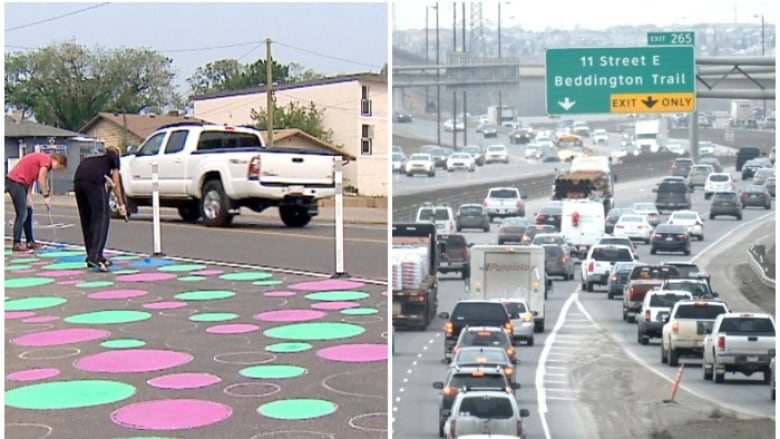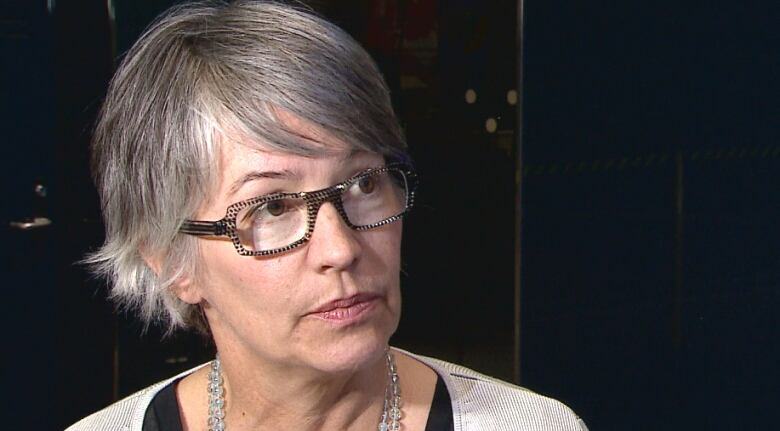How to design a road that shouts, 'slow 'er down!'
If Calgary wants to reduce speeds, we have to design roads that speak to our subconscious

This article was originally published on Oct. 5.
Think about the last time you drove.
How did you calculate the curvature of the road and compensate your speed? When exactly was it that you decided to apply the brake to reduce velocity, or hit the gas to leverage forward momentum while going through an intersection? Do you remember all the oblique angles, indication signs, controlled intersections? Were thereother vehicles spatially aligned and how did you analyze the variant road surfaces? Or did youzone out?
It turns out it's not really you driving your vehicle, it's your subconscious.
But it has some help.
The asphalt that speeds us along from place to place, cocooned in our cars, is talking to us in a voice we rarely hear. Engineers and designers leverage cognitive science to act on our subconscious andcause us to drive in particular ways. The "voice" of the road design can actually, deliberately, suppress our need to concentrate, or jolt our minds to focus on the task at hand.
It's a science, and one that's evolving around the world and right here in Calgary.
A menu of tricks
Ben Hamilton-Baillie is an expert in manipulating drivers. He pulls from a menu of tricks to redesign streets and intersections throughout the U.K. in an effort to keep drivers on their toes and speeds down.
Hamilton-Baillie is from a school of thought, a philosophy of road design, that believes you have to create an environment where drivers want to slow down often by eliminating the hard barriers between cars and pedestrians.
His tricks are effective not only in reducing collisions and reducing speedsbut also in making traffic move more efficiently. Sometimes, his recommendations are downright counterintuitive. Slow traffic by removing signs and lights and travel times can drop.Do it rightand it works.
Recently in Calgary, there's been a brouhaha over lowering the speed limit. No matter which side you fall on in the debate, it's interesting to look at the science behind such things.
The consensus, amongroad designers, is that you can't just say the speed limit is lowerand you're done.
Rather, you have to ensure the roads are designed in such a wayas to subconsciously cause drivers to slow down making it feel uncomfortable to race down residential roads.

Hamilton-Baillie said there's a menu of about a half-dozen measures to do that.
Shrink the lanes in width, just a little, and people inherently drive slower. Orjust create the illusion they're smallerand people will also apply the brakes. How to do that?
One way is to put treesor benches beside the road and, as you drive, your eyes need to capture them and your brain needs to process where they are in space and time. That takes time, soyou'll slow down to give your brain a momentwithout even thinking about it.
Another trick: Change the physical design of road signs that people associate with highways and high-speed roads and your brain will process the information differently. In other words, don't put the same signs on the Deerfoot as you would on 13th Avenue S.W.
"If the driver is a little bit uncertain, they drop their speed, sure as eggs is eggs," said Hamilton-Baillie.
He says adding"punctuation marks" along a road things like intersections, landmarksor crossings helps slow down the drive. Above and beyond the processing time it takes your brain, it also gives drivers something to pass by, which makes you feel like you're actually getting somewhere.
"We spend a lot of time trying to make sure you introduce even minor incidents, so the driver is moving from place to place like going down though a series of rooms," said Hamilton-Baillie.
What this represents is a fundamental shift in thinking. Where once we built for the speed of cars, now we build for the safety of people drivers included.
And it's happening here in Calgary.
The benefits of uncertainty
What road designers and engineers are aiming foris to remove the subconscious guiding hand of the road and force drivers to think. They do that by creating a certain uncertaintyin drivers.
Tony Churchill is a senior traffic engineer here in Calgaryand the leader of the city's traffic safety. If you see those yellow concrete barriers jutting into a local intersection, Churchill isone of the reasons why.
Historically, he says, engineers designed a road for a certain speed and the anticipated level of traffic. They'd consider sightlines and lane widths, shoulders and how long it would take a reasonable driver to react to a situation. Then they'd make sure drivers could go 10 km/h over the speed limitjust to ensure some wiggle room.

With roads designed this way, people were speeding, dangerously.
"There was a general recognition that we had relatively poor compliance, and this was true of engineering all around the world. That factor of safety doesn't really work when psychology kicked in," said Churchill.
Enter more psychology.
No more wiggle room
Whenroads in Calgary talk to you, most of them are urging you to drivea certain speed. Usually to maximize traffic flow. For our major thoroughfares, that's a good thing. And it seems to make sense. Build big roads that are easy to driveand get you quickly from place to place.
Butthere's a problem when that thinking enters a neighbourhood. If you feel subconsciously comfortable on the road, youdrive faster.
"Unfortunately, people are pretty good at judging their environment and they feel safe, so they actually drive at that higher design speed rather than the posted speed," says Churchill.
So Churchill wants to design distractions, which on smaller roadswill calm traffic. Get you to take your foot off the gas.
New, smaller roads in Calgary are now designed for the posted speed limit. No more adding that 10 km/h extra into the design. Andthe city's guide for road design now encourages peripheral distractions: trees, bike lanes and sidewalks.

But even the subtlest of changescan make a difference. Slower, or faster.
"There have been quite a few studies around the world that show that just the simple act of putting a yellow line on a roadway increases the speed a little bit, because it's a cue that as a motorist, this is my space," said Churchill.
The city wants people to move efficiently along major roads. So, on major routes they do the opposite of what small roads do. They add shoulders, eliminate trees or hide them behind barriers, ensure good lighting and create the ability to see into the distance as much as possible. That also comes back to those yellow lines. They need to show the driver the lay of the road into the distance.
If you want to understand why designers hide distractions on major roads, just think of what happens when a car is stalled on the side of a freeway. One bit of clutter and the patterns change. You slow down to lookand process what you see.
We need to trick the mind.
The mind rebels
Of course, whenever one toys withthe human mind, the human mind comes up with all kinds of reasons to misbehave.
If you reduce the speed of a roadbut don't design in those external distractions, you run the risk that drivers will start focusing on what one researcher called "in-vehicle tasks." Think messing about with your cellphone, or fiddling with your radio dial.
So this slower roads thinghas to be done right.
Designers and planners say you can't just slap a new speed limit down and say "obey."
It's that part of the conversation where Calgary now finds itself.
The politics of speed
Coun. Druh Farrell recently introduced a motion in council asking for the city to reduce the default speed limit in Calgary to 30 km/h, down from 50. After much toing and froing, the motion was amended to ask administration whether it should be 40 or 30 km/h.
Part of that motion calls for short-, medium- and long-term solutions for redesigning residential roads to reflect the new reality.
"The easy part is designing new communities with safety in mind and liveability in mind stop the bleeding, really, by designing better behaviours into the neighbourhoods," said Farrell.

That's the relatively cheap option. The more expensive one is the retrofit of older roads.
Farrell says the city has a pretty good idea of trouble spots, both through data and from speaking with the people who live in communities. But she thinks we're a long way off from the funky and famed pedestrianized streets of Copenhagen and Amsterdam, strewn with benches, trees, artwork and bike paths.
"We use those as sort of the pinnacle, the excellent examples of how they've taken their city and transformed it over time to be more humane and walkable, but they didn't start out that way," she said.
"They've retrofitted their city over the past generation or two."
Time. And money.
Slabs of yellow concrete
How Calgary will transform itself is still up for discussion. The price:TBD.
Churchill, the senior traffic engineer, said city staff are just starting to think about how they would rebuild smaller roads if council decides the speed limit should drop.
"I can definitely see that it would be types of things like the traffic calming that we've been doing over the past years, but just potentially accelerated and consistently across the city. So more of a strategic approach to it rather than just a concern-requested basis."
And it doesn't need to break the bank.
Think about those slabs of yellow concrete you see jutting out into traffic lanes in some neighbourhoods. Or about roundabouts, or communities painting designs on the sides of roads, or even speed bumps. These are changes that don't need to be expensive.

A recent and relatively quick traffic calming scheme in Erin Woods in southeast Calgary cost $120,000.
You could just add trees adjacent to a roadand not even touch the pavement.
But, when you consider there are more than 200 neighbourhoods in Calgary, well, yikes. The price tag could stretch into the millions when you're talking a major overhaul.
Yet Churchill says that when it comes to accidents, forcing behaviour change through design can make a profound difference.
"It won't take too long and we'll be at the point where we just have the rare and random incidents that are spread across the city."
But change is hard.
The pushback
Mess around with Calgarians' roadsand you're going to hear about it. People get upset when they think their freedom to travel as they see fit has been curtailed.
Yet, back in the U.K., Hamilton-Baillie says that's not abad thing.
"Every scheme I've done I get people complaining to me: 'I drove through there, I didn't know what I was supposed to do, I couldn't work it out'. And I think 'great.' Because if you're driving half a ton of metal, you shouldn't be too certain, you shouldn't have any confidence."
The report on speed reduction in Calgary will out come next year.
Calgary: The Road AheadisCBCCalgary's special focus on our city as it passes through the crucible of the downturn: the challenges we face, and the possible solutions as we explore what kind of Calgary we want to create. This story is part of a sub-series on roads and how they shape our lives. Have an idea for a future story? Email us:calgarytheroadahead@cbc.ca
- ANALYSIS |How Alberta built enough roads to reach the moon
- ANALYSIS |Why slamming on the brakes won't stop a new kind of speed camera that could end up on Alberta roads
- ANALYSIS |How we could build roads for fallible humans rather than 'perfect operators'
- AUDIO |Why are people such jerks on the road? A Calgary driver, cyclist and pedestrian weigh in













_(720p).jpg)


 OFFICIAL HD MUSIC VIDEO.jpg)
.jpg)



























































































